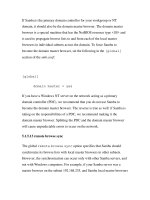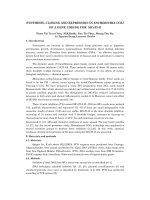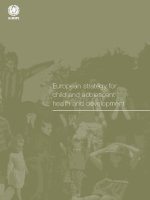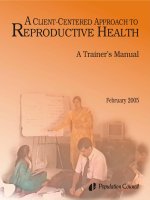Tài liệu Open Hearing: Adolescent Sexual and Reproductive Health and Rights in the Pacific pdf
Bạn đang xem bản rút gọn của tài liệu. Xem và tải ngay bản đầy đủ của tài liệu tại đây (132.6 KB, 5 trang )
1
Open Hearing: Adolescent Sexual and Reproductive
Health and Rights in the Pacific
Questions and Answers
• Why is the New Zealand Parliamentarians Group on Population and
Development (NZPPD) hosting this Open Hearing?
The New Zealand Parliamentarians’ Group on Population and Development
(NZPPD) provides a forum for New Zealand parliamentarians to engage and
act on international population and development issues. The NZPPD is a
cross party group, currently with 47 members representing just under 40
percent of all New Zealand MPs. NZPPD was established in 1998 to further
the International Conference on Population and Development (ICPD). The
aim of this Open Hearing is to better understand adolescent sexual and
reproductive health and rights and related issues in Pacific Island Countries
and Territories (PICTs). Through inputs on issues and solutions from people
and organisations working on the theme, NZPPD wishes to motivate
increased awareness, action, and investment in adolescent SRHR in the
Pacific.
• What are sexual and reproductive health and rights?
Sexual and reproductive health and rights (SRHR) is a phrase used to
encompass fundamental human rights relating to people’s sexual and
reproductive health, as well as services that are required to ensure that all
people can fully realise these rights. Such services encompass, but are not
limited to: family planning services, including a comprehensive range of
contraceptives, commodities and information, education and counselling
services on sexuality, sexual and reproductive health and responsible
parenting; pre- and postnatal care services, including safe delivery services
and education; infertility services; safe abortion services (where legal) and
post abortion care services; treatment of reproductive tract infections and
sexually transmitted infections, including HIV and other reproductive
conditions.
• Why is there a need to focus on adolescent SRHR in the Pacific?
Firstly, adolescents have a fundamental human right to the highest attainable
standard of health, including sexual and reproductive health. While studies
indicate that 65% of girls and 72% of adolescents in the Pacific are sexually
active, there is a severe lack of knowledge and access to comprehensive
SRHR services and information. As a result, adolescents suffer a
disproportionate burden of poor sexual and reproductive health, including
high rates of teenage pregnancies, and sexual and reproductive illnesses.
2
Secondly, the Pacific has a rapidly growing adolescent population, with 56%
of the population under the age of 25 and 36% under the age of 15. Ensuring
that these adolescents have access to SRHR services and information is
therefore fundamental to avoid slowed progress towards social and economic
development goals, and an increased burden on government expenditures.
• What is the unmet need for family planning services and information for
adolescents in the Pacific?
The unmet need for family planning refers to the percentage of women
between the ages of 15-49 who are married or in a union, and who do not
want another birth, but are not using contraception. There is a great need to
increase adolescent’s access to comprehensive, age-appropriate family
planning services and information in the Pacific. Available data indicates that
between 11% and 52% of Pacific women between 15-19 years old who are
married or are in civil unions have an unmet need for family planning. Less
than 20% of girls aged 15-19 and less than half of adolescent boys in the
Pacific report having ever used a modern method of contraception, including
condoms. Studies indicate that providing SRH information early on in life can
have long-term protective benefits. Adolescents are less likely to have heard
family planning messages in the media, and less than 25% of Pacific girls
have discussed family planning with a health worker.
• What is the rationale for New Zealand to support the improvement of
adolescent SRHR in the Pacific?
As a Pacific nation, New Zealand’s close geographic proximity and strong
economic and cultural ties with other Pacific countries further underscores the
importance of supporting positive change in this region. The New Zealand Aid
Programme focuses on areas and activities where New Zealand’s
development assistance can have the most positive impact, and over half of
New Zealand’s total aid goes to this region. One of the stated health priorities
of the New Zealand Aid Programme is sexual and reproductive health.
Further, due to the financial crisis, a range of international donors active in the
Pacific and which support SRHR, have announced they will be withdrawing,
reducing their support or have already done so. New Zealand’s support is
therefore more critical than ever before.
New Zealand is committed to promoting the objectives of the Millennium
Development Goals and the International Conference on Population and
Development (ICPD) - both of which specifically require the advancement of
SRHR - and in April 2012 at the 45
th
session of the Commission on
Population and Development (CPD) joined other UN member states in
agreeing to a landmark resolution on adolescent SRHR. SRHR services have
been shown to: save lives, improve health, empower women, increase
women’s access to education and employment, contribute to healthier and
wealthier families, slow rapid population growth and advance socio-economic
3
development. SRHR services – particularly family planning – has also been
shown to be one of the most cost efficient health interventions available.
• How does a lack of SRHR services and information impact adolescents?
Adolescent fertility rates are high in many Pacific countries, with little decline
in the past decade. For example, between 8-26% of girls aged 15-19 who are
married or in civil unions have already started childbearing, and 17 and 62%
of recent births were unplanned. This reflects that adolescent pregnancy in
the Pacific often occurs outside of marriage and is commonly unintended.
Adolescent girls who become pregnant are at an increased risk of physical or
mental abuse and are often less able to complete their education, find
employment and therefore more likely to remain in poverty. Teenage
pregnancy is linked to an increased risk of unsafe abortion, which can lead to
injury, infertility, chronic reproductive health issues and death. While there is a
lack of data specific to the Pacific, on a global scale between 2 and 4.4 million
adolescents resort to unsafe abortions every year. Family planning gives
women and girls more agency over their own lives, by enabling them to
postpone early marriage and childbirth, and keeping girls in school for longer.
• Can family planning play a role in the fight to prevent the spread of
HIV/AIDS?
Pacific country populations remain highly vulnerable to HIV infection due to,
small highly mobile populations, high rates of STIs and high rates of at risk
sexual behaviour. There have been approximately 30,000 reported cases of
people living with HIV in the Pacific, but this figure is under-representative
due to limited surveillance capacity across the region. Notably, cases from
Papua New Guinea make up a significant majority of the total cases detected
in the Pacific—from 21% in 1989 to over 99% in 2008. Condoms are a core
method of family planning and are the only form of contraception that can
effectively prevent against HIV transmission. When coupled with a
comprehensive range of SRHR services including prevention of mother to
child transmission (PMTCT) and voluntary counselling and testing (VCT),
SRHR services present one of the most effective tools in the fight against the
spread of the epidemic.
• Is New Zealand imposing family planning services on developing
countries in the Pacific?
No. Men and women who participate in New Zealand-supported family
planning projects do so voluntarily, free of coercion, and with fully informed
consent. In particular, New Zealand-supported family planning projects aim to
meet existing demand for family planning services. Best available data
suggests that between 11% and as much as 46% of this demand is currently
unmet. Family planning plays an important role in human and economic
4
development. About 130 national governments worldwide subsidize family
planning services, including about 65 developing countries.
• Does providing SRHR services and information to adolescents
encourage sexual activity?
No. Many studies show that access to comprehensive sexuality education
promotes responsible attitudes and behaviour. These studies also show that
providing adolescents with information and services on reproductive and
sexual health enables them to postpone the onset of sexual activity and
encourages them to have fewer partners. When these young people do
engage in sex, they are more likely to protect themselves from pregnancy and
sexually transmitted infections, including HIV.
• How is SRHR related to achieving the Millennium Development Goals?
Research has shown that ensuring sexual and reproductive health and rights
is essential for reaching all 8 of the Millennium Development Goals (MDGs):
1. Eradicate extreme poverty and hunger. When families are able to plan
the spacing and number of children, they are able to invest more in
each child’s nutrition and health, which can reduce poverty and
hunger for all members of a household. At a macro-level, ensuring
SRHR can also enable faster social and economic development.
2. Achieve universal primary education. Families with fewer children, and
children spaced further apart, can afford to invest more in each child’s
education. This has a special benefit for girls, whose education may
have lower priority than that of boys. In addition, girls who have
access to family planning services and information are less likely to
become pregnant and drop out of school.
3. Promote gender equality and empower women. Being able to plan
whether and when to have children is a key aspect of women’s
empowerment. Women who can plan the timing and spacing of their
children also have greater opportunities for work, education and social
participation outside the home.
4. Reduce child mortality. Prenatal care and the ability to avoid high-risk
births helps to prevent infant and child deaths. Children in large
families are likely to have reduced healthcare, and unwanted children
have a higher rate of mortality and morbidity. It is estimated that by
reducing current unmet need for family planning, 640,000 newborn
deaths could be averted each year.
5. Improve maternal health. Preventing unplanned and high-risk
pregnancies and providing care in pregnancy, childbirth and the
postpartum period save women’s lives. It is estimated that by meeting
global unmet need for family planning, 150,000 maternal deaths could
be averted each year.
5
6. Combat HIV and AIDS, malaria and other diseases. Sexual and
reproductive health care includes preventing and treating sexually
transmitted infections, including HIV and AIDS. In addition,
reproductive health care can bring patients into the healthcare system,
encouraging diagnosis and treatment of other diseases and
conditions.
7. Ensure environmental sustainability. Providing sexual and
reproductive health services can help slow rapid population growth,
urban migration and reduce pressure on the environment and
resources. When women are able to have smaller families, they are
also better able to adapt to the effects of climate change.
8. Develop a global partnership for development. Affordable prices for
drugs to treat HIV and AIDS and a secure supply of contraceptives
would greatly advance reproductive health programs in all developing
countries.









